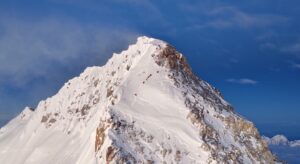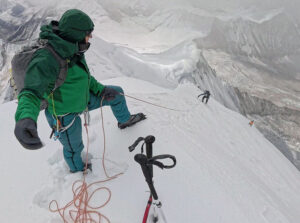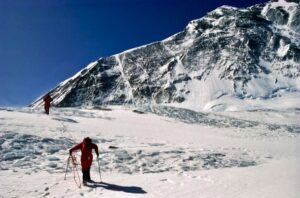Four months before the Everest season, authorities are trying to deal with a pressing problem: the effects of climate change on the Khumbu Glacier. Specifically, how safe is Base Camp, and should they do something about it?
Last fall, Andrzej Bargiel said he wanted to ski Everest as soon as possible because “global warming is affecting the high-altitude mountains and this activity may not be feasible in 10 years.”
During the 2022 spring season, some climbers mentioned that the glacier behind their tents was so unstable that they felt insecure at times. Sito Carcavilla, one of the last summiters of the season, recently mentioned in a lecture that authorities were planning to move the Base Camp from the glacier to the top of a lateral moraine.
Below, the Everest summit video by Sito Carcavilla.
How safe is the Khumbu Glacier?
However, it is far from clear if or where Everest Base Camp will be moved. There is no unanimous opinion about either its state or possible corrective measures.
Nepal’s Ministry of Tourism has set up a committee to study the relocation issue. Nima Nuru Sherpa, president of the Nepal Mountaineering Association, is heading the initiative. Among those consulted is Dawa Steven Sherpa, CEO of Asian Trekking and an outstanding figure in environmental and conservational issues in Nepal.
Dawa Steven found time to discuss the Everest Base Camp issue with ExplorersWeb.

Everest Base Camp at night.
‘EBC is in the safest location it can be’
Did you notice anything unusual about Everest Base Camp last season? Was the glacier more unstable than usual or were the tents more at risk of sinking into hidden crevasses?
Dawa Steven: Base Camp and the Khumbu Glacier on which it sits is no more unstable than in the past. There certainly are no cavities under the ice that could swallow up Base Camp or pose a threat to anyone’s life. Also, no crevasses are suddenly ripping open overnight to devour tents.
Having said that, it’s definitely warmer on the mountain than it used to be, and there are indicators that reflect that. There are larger serac collapses and avalanches on the slopes of Nuptse, the west shoulder, and Pumori than previously. They are also more frequent. A stream now flows through Base Camp year-round, and the height of the pinnacles there is measurably lower than before.
As the ice underfoot melts much faster during the climbing season, it requires us to fix the floors of our tents more frequently. More concerning though, the Icefall feels less stable. Changes to the route do seem to happen faster now.

Meltwater pool by the Khumbu Glacier. Photo: Inhabitat
Is Everest Base Camp safe in its current location?
It is in the safest location it can be. The avalanches off the slopes of the west shoulder, Nuptse, Pumori, etc. are a bigger concern to me than the alleged instability of the Khumbu Glacier. As such, I would say that Base Camp is safer where it currently is than if it were relocated onto the lateral moraine, closer to the avalanches.
Same location for 2023
What are the odds that EBC will be moved for 2023?
This decision is not advanced at all, and the Ministry is simply studying if it’s even necessary to do so. In any case, the Ministry has clearly said to me that this will in no way will impact the 2023 season. In other words, Base Camp will not be relocated by then, if ever.

Dawa Steven Sherpa on his latest Everest summit, four years ago. While he doesn’t always lead the climbing team, he overviews EBC every season. Photo: Dawa Steven/Facebook
Even if Everest BC were moved farther away from the Khumbu Icefall, what would prevent teams from setting up an Advanced Base Camp on the glacier, where it was before?
It would be difficult to argue against putting up a camp at the current Base Camp. In the past, Everest has had various permutations regarding locations and the number of camps on each part of the mountain.
Hypothetically, any forced relocation of Base Camp, or any other camp for that matter, opens up a much bigger discussion about the self-determination of the climber and the role of government. Also, the question of responsibility and liability may arise should an accident happen at the government-designated campsite.
Keeping Sherpas safe
Everest expeditions will have to deal with climate change anyway. Any good ideas to improve the situation in the near future?
Climate change is certainly affecting all the Himalaya, and climbing on Everest is going to have to adapt. We have to do whatever we can to keep climbers, and climbing Sherpas in particular, safe. This would entail both policy changes and better use of technology without compromising the spirit of mountaineering.
For example, the government could allow a cache of equipment at Camp 2 so Sherpas don’t have to take the same equipment up every season. To ensure that the equipment cache is not dumped, the government could hold on to a deposit, in case the responsible company does not come back the following season. This deposit could go toward removing the equipment from the mountain.
As for technology, there are many possible solutions, from making more use of helicopters (admittedly a contentious subject) to using motion capture technology to inform in real time about changes to the Icefall and the seracs. Also, more weather stations and possibly even weather radars would give much better forecasts. This would make not only mountaineering but also aviation safer.

Climbers on top of the Khumbu Icefall. Photo: Seven Summit Treks
Helicopters to Camp 2
In recent seasons, rope-fixing teams and gear are being airlifted to C2, in order to avoid the Khumbu Icefall. Also, Marc Batard says he wants to open and fix with lines and ladders an alternative route across the flank of Nuptse to C2. Do you think either of these measures will become the norm?
The use of helicopters to shuttle equipment and rope-fixing teams is a testament to the improvement in the performance of these aircraft and the reduction of their operating costs. This option was not viable in the past. These are market forces and not a response to climate change.
Objectively speaking, I cannot see the difference for the “average Everester” whether the ropes were carried up by Sherpas through the Icefall or flown up by chopper over it. Of course, it is not mountaineering to the puritanical alpinist, but Everest never has been. Throw into that argument that it will reduce the Sherpas’ exposure to the Icefall, thus keeping them safer, and it’s a difficult argument to counter. Subjectively speaking though, I do believe that there needs to be a reasonable limit to the use of helicopters.
Batard’s route: harder, more avalanche-prone
As far as Marc Batard’s new route is concerned, I would love to be proven wrong but I don’t think that it is a viable option for Sherpas. It is a longer, tougher, and apparently more avalanche-prone route. As one of my sirdars laughingly told me, “If I tell the Sherpas to use that route, they’re going to kill me.”
Nevertheless, I think it’s a great exercise in exploring and seeking unconventional solutions, so I do appreciate his efforts.
What do you think of Andrzej Bargiel’s comments about needing to ski down Everest asap, before global warming makes it impossible?
I am not an extreme skier and can’t say what conditions he needs to ski. It’s true that the snowline has receded much farther up the mountains in recent decades. At the same time, heavy precipitation is also more frequent. [In fact, heavy snowfall thwarted Bargiel’s attempt this fall.] I’ll leave that one up to the skiers.

Andrzej Bargiel and Janusz Golab climb the Lhotse Face on their Everest attempt last fall. Photo: Bartek Bargiel
Dawa Steven Sherpa, CEO of Asian Trekking, has summited Everest three times, as well as five other 8,000’ers and many lesser peaks. Dawa’s environmental and conservation efforts have been globally recognized by many international agencies, including the International Union for Conservation of Nature (IUCN), World Wildlife Fund (WWF), and the International Olympic Committee. He is also a climate change ambassador for WWF and patron of the Duke of Edinburgh’s International Award Nepal.
Dawa’s father is Ang Tschering Sherpa, founder of Asian Trekking and his mother is from Belgium. Dawa grew up in Nepal and speaks five languages.






